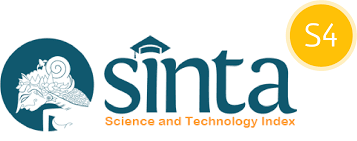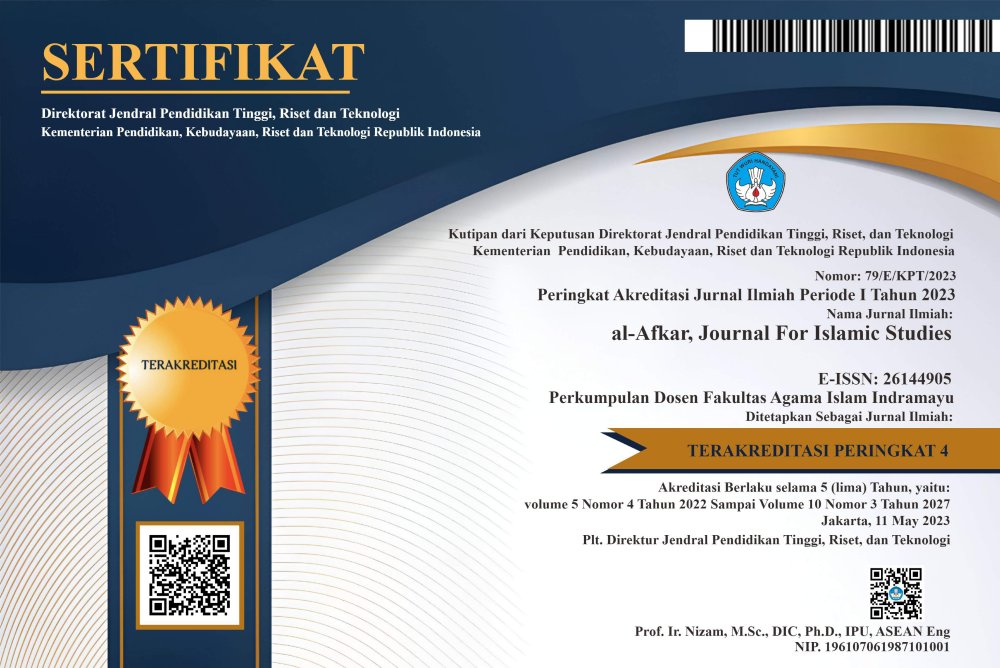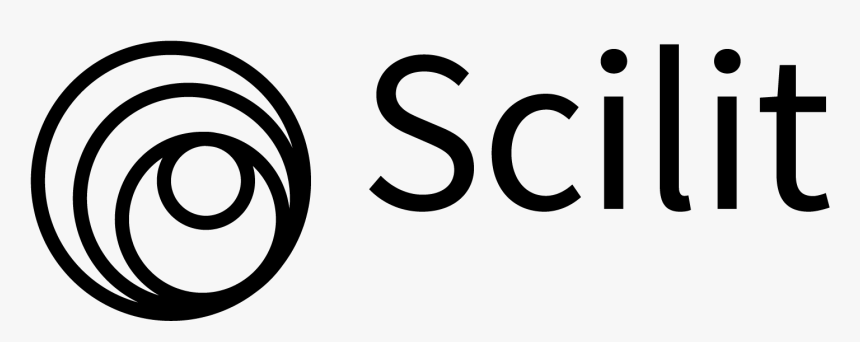Semantic Analysis of the Meaning of Al-‘Ilmu in the Qur'an from Toshihiko Izutsu's Perspective
DOI:
https://doi.org/10.31943/afkarjournal.v8i2.2163Keywords:
Al-‘Ilmu, Qur'anic Semantics, Toshihiko Izutsu, Relational Meaning, Qur'anic, WeltanschauungAbstract
This study aims to analyze the meaning of the concept of al-‘ilmu in the Qur'an using Toshihiko Izutsu's semantic approach. The research focuses on three main dimensions: the basic meaning, relational meaning, and historical meaning of the term al-‘ilmu. The research method used is a qualitative descriptive analysis with syntagmatic and paradigmatic approaches. The research data were obtained from Qur'anic verses containing the term al-‘ilmu as well as classical references such as Mufradat Alfadz al-Qur'an by Raghib al-Asfahani and Lisan al-Arab by Ibn Manzur. The results show that al-‘ilmu has a basic meaning of knowledge and awareness. Relationally, al-‘ilmu is often associated with concepts such as hikmah (wisdom), huda (guidance), and taqwa (piety). Historically, the meaning of al-‘ilmu evolved from general knowledge in pre-Qur'anic societies to a concept encompassing theological, epistemological, and ethical perspectives in Islam. These findings contribute significantly to the study of Qur'anic semantics and the understanding of Islamic epistemology.
Downloads
References
A. Alduhaim, “Translating near-synonyms in the quran: A semantic analysis of three near-synonyms and their english translations,” 3L Lang. Linguist. Lit., vol. 27, no. 1, pp. 76–89, 2021, doi: 10.17576/3L-2021-2701-06.
M. Qassem, “Style and meaning in translations of the Qur’anic verb-noun collocations into English,” PSU Res. Rev., vol. 5, no. 3, pp. 201–214, 2021, doi: 10.1108/PRR-12-2020-0041.
M. Syafirin, “The Meaning of Shalat in Al-Qur’an : Semantic Analysis of Toshihiko Izutsu Makna Ṣalat dalam Al-Qur’an : Analisis Semantik Toshihiko Izutsu,” Alif Lam, vol. 1, no. 1, pp. 10–20, 2020.
B. Baidawi and I. Amalih, “Konsep Ilmu Ladunî Dalam Al-Quran (Study Atas Tafsir Sufi Al-Qusyairi Dalam Lataif Al-Isyarat),” El-Waroqoh J. Ushuluddin dan Filsafat, vol. 4, no. 2, 2020, doi: 10.28944/el-waroqoh.v4i2.316.
D. Y. Nahri, “Epistemologi Jahl Dalam Al-Qur’an Perspektif Kitab Al-Qur’an Dan Tafsirnya (Edisi Yang Disempurnakan),” Revel. J. Ilmu al-Qur`an dan Tafsir, vol. 1, no. 1, pp. 1–16, 2020, doi: 10.19105/revelatia.v1i1.3168.
H. Hardivizon and M. Mufidah, “Emotion Control in the Qur’an: Study of Toshihiko Izutsu’S Semantic Approach To Kaẓim Verses,” J. At-Tibyan J. Ilmu Alqur’an dan Tafsir, vol. 6, no. 2, pp. 221–242, 2021, doi: 10.32505/at-tibyan.v6i2.3316.
M. Taqiyudin, S. Supardi, and A. N. Huda, “Makna Dasar Dan Makna Relasional Pada Kata Al-Balad Dalam Al-Qur’an: Kajian Semantik Toshihiko Izutsu,” Zawiyah J. Pemikir. Islam, vol. 8, no. 2, p. 113, 2022, doi: 10.31332/zjpi.v8i2.5463.
A. Mudakir, D. Darmawan, and W. Taufiq, “The Meaning of Hawa in the Qur’an: A Semantic Analysis of the Perspective Toshihiko Izutsu,” J. Iman dan Spiritualitas, vol. 2, no. 2, pp. 155–166, 2022, doi: 10.15575/jis.v2i2.16972.
M. Rifaldi, “Analisis Semantik terhadap Konsep Al-Falah di dalam Al-Qur’an,” J. Iman dan Spiritualitas, vol. 2, no. 4, pp. 539–550, 2022, doi: 10.15575/jis.v2i4.19214.
E. Yulianti, B. Zulyeno, and M. N. Naser, Sociolinguistics as a Method to Interpret the Physical Existence of Heaven and Hell in the Qur’an, vol. 1. Atlantis Press SARL, 2024. doi: 10.2991/978-2-38476-108-1_23.
D. Darmawan, I. Riyani, and Y. M. Husaini, “Desain Analisis Semantik Alquran Model Ensiklopedik: Kritik atas Model Semantik Toshihiko Izutsu,” AL QUDS J. Stud. Alquran dan Hadis, vol. 4, no. 2, p. 181, 2020, doi: 10.29240/alquds.v4i2.1701.
D. Sholehah, “MENGENAL AL-MUNASABAH,” vol. 2, no. 1, pp. 79–92, 2022.
H. Hassanein, “Antonym Sequence in Qur’anic Arabic: An Emically Etiological Approach,” Jordan J. Mod. Lang. Lit., vol. 15, no. 1, pp. 199–220, 2023, doi: 10.47012/jjmll.15.1.11.
M. S. Kadwa and H. Alshenqeeti, “International Journal of Linguistics, Literature and Translation (IJLLT) The Impact of Students’ Proficiency in English on Science Courses in a Foundation Year Program,” Int. J. Linguist. Lit. Transl., vol. 3, no. 11, pp. 55–67, 2020, doi: 10.32996/ijllt.
J. Berglund and B. Gent, “Qur’anic education and non-confessional RE: an intercultural perspective,” Intercult. Educ., vol. 30, no. 3, pp. 323–334, 2019, doi: 10.1080/14675986.2018.1539305.
P. Rachman, “Implikasi Konsep Islamisasi Ilmu Pengetahuan Ismail Raji Al-Faruqi,” HUMANISTIKA J. Keislam., vol. 6, no. 2, pp. 154–170, 2020, doi: 10.55210/humanistika.v6i2.369.
N. A. A. Samsuddin, N. Nordin, R. Embong, S. Ismail, R. Usop, and S. K. Ismail, “Islamic Economic Thoughts of Prominent Muslim Scholars in the Abbasid Era,” Int. J. Acad. Res. Bus. Soc. Sci., vol. 10, no. 12, pp. 26–35, 2020, doi: 10.6007/ijarbss/v10-i12/8212.
M. Muslimah, H. Hamdanah, and N. Nina, “science in Islamic perspective,” Int. Res. J. Manag. IT Soc. Sci., vol. 7, no. 6, pp. 66–71, 2020, doi: 10.21744/irjmis.v7n6.1010.
A. Y. Y. Mas’ud Maulana, Hidayatul Fikra and M. Chodijah, “Gunung Djati Conference Series, Volume 8 (2022) The 2nd Conference on Ushuluddin Studies,” Gunung Djati Conf. Sains, vol. 8, pp. 630–638, 2022.
A. M. Mafrudlo and N. Nurrohman, “Contextualization and Synergy of the Concept of Justice in Islamic Economic Development,” Indones. Interdiscip. J. Sharia Econ., vol. 5, no. 2, pp. 815–833, 2022, doi: 10.31538/iijse.v5i2.2422.
J. Keagamaan, D. Pembelajarannya, U. Islam, N. Saifuddin, and Z. Purwokerto, “Edu-Religia The Development of Science in the Digital Era and Its Influence on Islamic Culture Asep Dadang Abdau,” vol. 6, no. 2, 2023.
“A Discourse of Traditional-cum-Modern Scholarship,” vol. 5, no. June, pp. 23–44, 2020, doi: 10.36476/JIRS.5.
B. Subagiya, S. Sauri, and B. Handrianto, “Integrating Islamic Worldview for Sustainable Identity in Science Textbooks in Indonesia,” Formosa J. Multidiscip. Res., vol. 3, no. 5, pp. 1497–1506, 2024, doi: 10.55927/fjmr.v3i5.9052.
T. Izutsu, Ethico-Religious Concepts in the Qur’an. in McGill Islamic studies. McGill-Queen’s University Press, 2002. [Online]. Available: https://books.google.co.id/books?id=LWWGlYPjRhkC
S. Faris, “Exploring The Divine Message: Quranic Studies in The Context of Islamic Scholarship,” Dirasah Int. J. Islam. Stud., vol. 1, no. 2, pp. 111–125, 2023, doi: 10.59373/drs.v1i2.16.
T. Izutsu, The Structure of Ethical Terms in the Quran. ABC International Group, Incorporated, 2000. [Online]. Available: https://books.google.co.id/books?id=VhsqAQAAMAAJ
T. Izutsu, “Kur ’ an ’ Da Allah Veİ Nsan,” 1975.
T. Izutsu, Konsep kepercayaan dalam teologi Islam: analisis semantik Iman dan Islam. Tiara Wacana Yogya, 1994. [Online]. Available: https://books.google.co.id/books?id=YqjMAAAACAAJ
Sudarta, “済無No Title No Title No Title,” vol. 16, no. 1, pp. 1–23, 2022.
S. Chukhanov and N. Kairbekov, “The importance of a semantic approach in understanding the texts of the Holy Quran and Sunnah,” Pharos J. Theol., vol. 105, no. 3, pp. 1–11, 2024, doi: 10.46222/pharosjot.105.36.
Downloads
Published
How to Cite
Issue
Section
License
Copyright (c) 2025 Ikrom Nurdin Jamil, Ainur Rhain

This work is licensed under a Creative Commons Attribution 4.0 International License.



















